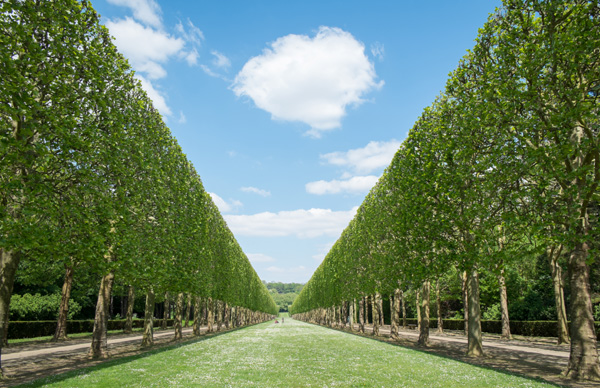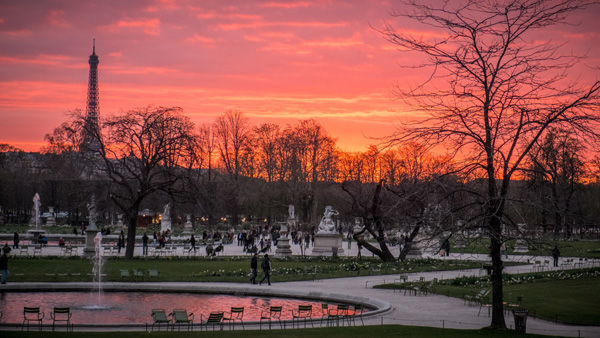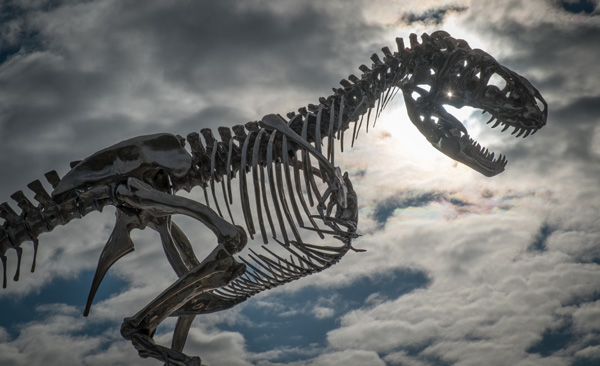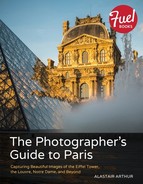Parks and Rivers
Paris is blessed with many beautiful parks and gardens spread throughout the city. The two largest parks, the Bois de Vincennes and Bois de Boulogne, sandwich the city from the east and west. The Seine River flows from east to west through the city, with many landmarks along the banks and beautiful bridges spanning its width. The river is joined in the city by the Canal Saint Martin.

Fujifilm X-E1, 18mm, ISO 200, 1/160s, f/8
Parks
The many small parks throughout the city each offer their own character and features. If you intend to do some golden hour photography, keep in mind that many of the smaller parks are closed overnight, so check the hours to make sure you can get access. While Paris offers too many parks to list, following are some of the highlights.
Tuileries Garden
The Tuileries Garden extends from the Louvre to Place de la Concorde and is very popular due to its central location. The gardens host a variety of sculptures and walkways with a central square and fountain, providing a good place for people watching and street/park photography. On the west side of the gardens, the Orangerie and Jeu de Paume buildings hold a variety of art exhibitions.
An 18-story (60-meter) Ferris wheel, the Roue de Paris, was constructed in 1900 at the Place de la Concorde. It is often transported to various locations around the world.

Fujifilm X-E1, 55mm, ISO 1600, 1/60s, f/8
Promenade Plantée
The Promenade Plantée, also known as the Coulée Verte, is a raised walkway through the 12th arrondissement in the east of the city. At just under three miles long, it follows the route of an old railway line, the Vincennes. The walkway runs from Bastille to the large park in the east, the Bois de Vincennes, and offers pretty gardens and an alternative view down onto the city streets. You can access the walkway via steps at various points along the route, with the first access point being a staircase at the junction between Avenue Daumesnil and rue de Lyon.
Jardin du Luxembourg
One of the largest parks in Paris, the Jardin du Luxembourg, is located in the 6th arrondissement. As well as beautiful gardens, shaded walkways, and tennis courts, the park contains the Luxembourg Palace, home of the French Senate.
Parc du Buttes Chamot
In northeast Paris, the large Parc du Buttes Chamot presents some unusual features such as steep slopes, a central lookout surrounded by an artificial lake, and a small cave complete with a waterfall.
Bois de Boulogne
The Bois de Boulogne is a huge park to the west of the city, just beyond the ring road, that features various botanical and landscape gardens, a zoo, and two horse-racing tracks. This is also the site of Roland Garros, host of the prestigious clay court tournament the French Open. A pretty boating lake not far into the park, Lac Inferieur, offers ferry boats to take you to a small island and cafe in the center of the lake.
Bois de Vincennes
The Bois de Vincennes on the eastern edge of the city is the largest park in Paris. It contains landscaped and floral gardens along with a velodrome, horse-racing track and zoo (reopened in 2014). The Temple of Love on Lac Daumesnil is a good spot for a few photos as is the Château de Vincennes, a former royal residence, especially in morning or evening light.
Parc de Sceaux
The Parc de Sceaux is in the town of Sceaux, about six miles outside of Paris but easily accessible on RER line B. The famous château at the park now houses a museum of local history, and the pretty grounds are worth a visit if you want to get away from the city.
By the River
The Seine runs through the heart of the city, with its island Île de la Cité being the original center. A walk along the river will take you to the Eiffel Tower, Invalides, the Grand Palais, the Louvre, and Notre Dame, to name just a few sights. Walkways on the left (south) bank, and occasionally on the right bank, through much of the city allow you to walk closer to the water and pass under the bridges. This is also a good way to escape the worst of the crowds.
Through some of July and August, the Paris Plages (Paris Beaches) are set up with sand and beach chairs to provide a beach-like experience in the center of the city. (Swimming is not recommended!)
Musée d'Orsay
The Musée d’Orsay is a beautiful museum, both as a building and in terms of its contents. It is much smaller than the Louvre, but also more manageable. Located on the south (left) bank of the river, it’s near to the Musée d’Orsay RER station (line C) and Solférino Metro station (line 12). The classic photograph to take here is from the inside looking out through the clock face, with other visitors in silhouette.
Bateaux-Mouches
One of the many companies providing boat trips along the river, Bateaux-Mouches earns a special mention thanks to the large chrome Tyrannosaurus that adorns its building. The Tyrannosaurus often proves to be photogenic, but the boat trips themselves aren’t great for quality photography. Powerful lights on the sides of the boats make a decent attempt at lighting the buildings on the banks of the river after sunset.

Fujifilm X-E1, 55mm, ISO 200, 1/1900s, f/13
Shakespeare and Company
Shakespeare and Company is a beautiful English-language bookshop situated just across the river from Notre Dame. The shop prohibits photography inside, but it’s still worth the time to explore and photograph the exterior and the secondhand books for sale in front of the shop. Then, put the lens cap on for a few minutes and enjoy the creaking shelves and narrow spaces in this great old establishment.
Les Berges
Les Berges (the barges) is a recently “pedestrianized” area on the left bank of the river between Pont d’Alma and Pont Royal, with plenty of seating, cafes, and games. A good place to relax for a summer evening with a baguette, cheese, and wine.
Canal Saint Martin
The Canal Saint Martin offers a pretty and usually quieter alternative to spending time by the river, and even has its own version of the river cruise. There are series of locks and bridges along its 3-mile length, although it also runs under some of the city between Bastille and Republique.
Bridges
A total of 37 bridges span the Seine in Paris. Following are my favorites:
• Pont de Bir-Hakeim. The Pont de Bir-Hakeim was formerly called the Pont de Passy, and is featured in the films Last Tango in Paris and Inception. The Metro line above provides a covered walkway with rows of pillars on each side. Also check out the architecture between the bridge and Passy station.
• Pont Alexandre III. Arguably the most ornate bridge in Paris, Pont Alexandre III is a single arch connecting Invalides with the Grand Palais near the Champs-Élysées. It was completed in 1900, at the same time as the Grand Palais and Petit Palais. Its lamps and various sculptures make it ideal to photograph at night.
• Passerelle Léopold-Sédar-Senghor. Passerelle Léopold-Sédar-Senghor is a beautifully designed single-span bridge covered in exotic woods. Try standing at the start of the bridge and wait for one or more people to form a silhouette at the crest of the bridge.
• Pont Neuf. The oldest standing bridge across the Seine in Paris, the stone construction of Pont Neuf is good for night shots. During the day, the corner of Île de la Cité under the bridge makes a good location for portraits.
• Pont des Arts. Also called Passerelle des Arts, Pont des Arts is a pedestrian bridge between the Louvre and the Institut de France. It’s covered in “lovers’” padlocks (either that or a lot of people have had their bikes stolen). Try close-ups of the padlocks, night shots of the Institute, or a low shot across the bridge between the wooden benches.
